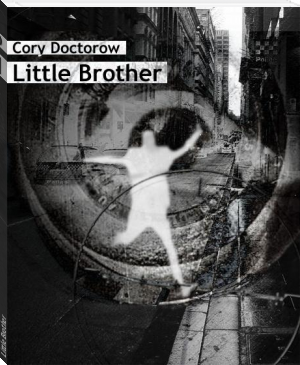Little Brother, Cory Doctorow [thriller novels to read .TXT] 📗

- Author: Cory Doctorow
Book online «Little Brother, Cory Doctorow [thriller novels to read .TXT] 📗». Author Cory Doctorow
We had a weepy dinner and Mom and Dad had each had a couple glasses of wine, which was a lot for them. I told them that I was getting sleepy, which was true, and mooched up to my room. I wasn't going to bed, though. I needed to get online and find out what was going on. I needed to talk to Jolu and Vanessa. I needed to get working on finding Darryl.
I crept up to my room and opened the door. I hadn't seen my old bed in what felt like a thousand years. I lay down on it and reached over to my bedstand to grab my laptop. I must have not plugged it in all the way -- the electrical adapter needed to be jiggled just right -- so it had slowly discharged while I was away. I plugged it back in and gave it a minute or two to charge up before trying to power it up again. I used the time to get undressed and throw my clothes in the trash -- I never wanted to see them again -- and put on a clean pair of boxers and a fresh t-shirt. The fresh-laundered clothes, straight out of my drawers, felt so familiar and comfortable, like getting hugged by my parents.
I powered up my laptop and punched a bunch of pillows into place behind me at the top of the bed. I scooched back and opened my computer's lid and settled it onto my thighs. It was still booting, and man, those icons creeping across the screen looked good
. It came all the way up and then it started giving me more low-power warnings. I checked the power-cable again and wiggled it and they went away. The power-jack was really flaking out.
In fact, it was so bad that I couldn't actually get anything done. Every time I took my hand off the power-cable it lost contact and the computer started to complain about its battery. I took a closer look at it.
The whole case of my computer was slightly misaligned, the seam split in an angular gape that started narrow and widened toward the back.
Sometimes you look at a piece of equipment and discover something like this and you wonder, "Was it always like that?" Maybe you just never noticed.
But with my laptop, that wasn't possible. You see, I built it. After the Board of Ed issued us all with SchoolBooks, there was no way my parents were going to buy me a computer of my own, even though technically the SchoolBook didn't belong to me, and I wasn't supposed to install software on it or mod it.
I had some money saved -- odd jobs, Christmases and birthdays, a little bit of judicious ebaying. Put it all together and I had enough money to buy a totally crappy, five-year-old machine.
So Darryl and I built one instead. You can buy laptop cases just like you can buy cases for desktop PCs, though they're a little more specialized than plain old PCs. I'd built a couple PCs with Darryl over the years, scavenging parts from Craigslist and garage sales and ordering stuff from cheap cheap Taiwanese vendors we found on the net. I figured that building a laptop would be the best way to get the power I wanted at the price I could afford.
To build your own laptop, you start by ordering a "barebook" -- a machine with just a little hardware in it and all the right slots. The good news was, once I was done, I had a machine that was a whole pound lighter than the Dell I'd had my eye on, ran faster, and cost a third of what I would have paid Dell. The bad news was that assembling a laptop is like building one of those ships in a bottle. It's all finicky work with tweezers and magnifying glasses, trying to get everything to fit in that little case. Unlike a full-sized PC -- which is mostly air -- every cubic millimeter of space in a laptop is spoken for. Every time I thought I had it, I'd go to screw the thing back together and find that something was keeping the case from closing all the way, and it'd be back to the drawing board.
So I knew exactly
how the seam on my laptop was supposed to look when the thing was closed, and it was not
supposed to look like this.
I kept jiggling the power-adapter, but it was hopeless. There was no way I was going to get the thing to boot without taking it apart. I groaned and put it beside the bed. I'd deal with it in the morning.
That was the theory, anyway. Two hours later, I was still staring at the ceiling, playing back movies in my head of what they'd done to me, what I should have done, all regrets and esprit d'escalier.
I rolled out of bed. It had gone midnight and I'd heard my parents hit the sack at eleven. I grabbed the laptop and cleared some space on my desk and clipped the little LED lamps to the temples of my magnifying glasses and pulled out a set of little precision screwdrivers. A minute later, I had the case open and the keyboard removed and I was staring at the guts of my laptop. I got a can of compressed air and blew out the dust that the fan had sucked in and looked things over.
Something wasn't right. I couldn't put my finger on it, but then it had been months since I'd had the lid off this thing. Luckily, the third time I'd had to open it up and struggle to close it again, I'd gotten smart: I'd taken a photo of the guts with everything in place. I hadn't been totally smart: at first, I'd just left that pic on my hard drive, and naturally I couldn't get to it when I had the laptop in parts. But then I'd printed it out and stuck it in my messy drawer of papers, the dead-tree graveyard where I kept all the warranty cards and pin-out diagrams. I shuffled them -- they seemed messier than I remembered -- and brought out my photo. I set it down next to the computer and kind of unfocused my eyes, trying to find things that looked out of place.
Then I spotted it. The ribbon cable that connected the keyboard to the logic-board wasn't connected right. That was a weird one. There was no torque on that part, nothing to dislodge it in the course of normal operations. I tried to press it back down again and discovered that the plug wasn't just badly mounted -- there was something between it and the board. I tweezed it out and shone my light on it.
There was something new in my keyboard. It was a little chunk of hardware, only a sixteenth of an inch thick, with no markings. The keyboard was plugged into it, and it was plugged into the board. It other words, it was perfectly situated to capture all the keystrokes I made while I typed on my machine.
It was a bug.
My heart thudded in my ears. It was dark and quiet in the house, but it wasn't a comforting dark. There were eyes out there, eyes and ears, and they were watching me. Surveilling me. The surveillance I faced at school had followed me home, but this time, it wasn't just the Board of Education looking over my shoulder: the Department of Homeland Security had joined them.
I almost took the bug out. Then I figured that who ever put it there would know that it was gone. I left it in. It made me sick to do it.
I looked around for more tampering. I couldn't find any, but did that mean there hadn't been any? Someone had broken into my room and planted this device -- had disassembled my laptop and reassembled it. There were lots of other ways to wiretap a computer. I could never find them all.
I put the machine together with numb fingers. This time, the case wouldn't snap shut just right, but the power-cable stayed in. I booted it up and set my fingers on the keyboard, thinking that I would run some diagnostics and see what was what.
But I couldn't do it.
Hell, maybe my room was wiretapped. Maybe there was a camera spying on me now.
I'd been feeling paranoid when I got home. Now I was nearly out of my skin. It felt like I was back in jail, back in the interrogation room, stalked by entities who had me utterly in their power. It made me want to cry.
Only one thing for it.
I went into the bathroom and took off the toilet-paper roll and replaced it with a fresh one. Luckily, it was almost empty already. I unrolled the rest of the paper and dug through my parts box until I found a little plastic envelope full of ultra-bright white LEDs I'd scavenged out of a dead bike-lamp. I punched their leads through the cardboard tube carefully, using a pin to make the holes, then got out some wire and connected them all in series with little metal clips. I twisted the wires into the leads for a nine-volt battery and connected the battery. Now I had a tube ringed with ultra-bright, directional LEDs, and I could hold it up to my eye and look through it.
I'd built one of these last year as a science fair project and had been thrown out of the fair once I showed that there were hidden cameras in half the classrooms at Chavez High. Pinhead video-cameras cost less than a good restaurant dinner these days, so they're showing up everywhere. Sneaky store clerks put them in changing rooms or tanning salons and get pervy with the hidden footage they get from their customers -- sometimes they just put it on the net. Knowing how to turn a toilet-paper roll and three bucks' worth of parts into a camera-detector is just good sense.
This is the simplest way to catch a spy-cam. They have tiny lenses, but they reflect light like the dickens. It works best in a dim room: stare through the tube and slowly scan all the walls and other places someone might have put a camera until you see the glint of a reflection. If the reflection stays still as you move around, that's a lens.
There wasn't a camera in my room -- not one I could detect, anyway. There might have been audio bugs, of course. Or better cameras. Or nothing at all. Can you blame me for feeling paranoid?
I loved that laptop. I called it the Salmagundi, which means anything made out of spare parts.
Once you get to naming your laptop, you know that you're really having a deep relationship with it. Now, though, I felt like I didn't want to ever touch it again. I wanted to throw it out the window. Who knew what they'd done to it? Who knew how it had been tapped?
I put it in a drawer with the lid shut and looked at the ceiling. It was late and I should be in bed. There was no way I was going to sleep now, though. I was tapped. Everyone might





Comments (0)